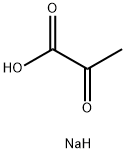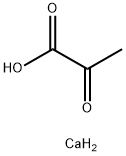Sodiumpyruvate , 99% , 113-24-6
Synonym(s):
Pyruvic acid sodium;Pyruvic acid sodium salt;Sodium pyruvate, Pyruvate;Α-ketopropionic acid sodium salt;α-Ketopropionic acid sodium salt
CAS NO.:113-24-6
Empirical Formula: C3H3NaO3
Molecular Weight: 110.04
MDL number: MFCD00002586
EINECS: 204-024-4
| Pack Size | Price | Stock | Quantity |
| 25g | RMB31.20 | In Stock |
|
| 100g | RMB37.60 | In Stock |
|
| 500g | RMB116.00 | In Stock |
|
| 1000g | RMB212.80 | In Stock |
|
| others | Enquire |
PRODUCT Properties
| Melting point: | >300 °C (lit.) |
| Boiling point: | >300℃ |
| Density | 1,267g/cm |
| vapor pressure | 0Pa at 20℃ |
| refractive index | 1,426-1,43 |
| storage temp. | 2-8°C |
| solubility | H2O: 100 mg/mL |
| form | solution |
| color | White to Pale Yellow |
| PH | pH(100g/l, 25℃) : 4.0~8.0 |
| biological source | synthetic (organic) |
| Water Solubility | Soluble in water. |
| BRN | 3568341 |
| Stability: | Stable. Incompatible with strong oxidizing agents. |
| InChIKey | DAEPDZWVDSPTHF-UHFFFAOYSA-M |
| LogP | -3.83 at 20℃ |
| CAS DataBase Reference | 113-24-6(CAS DataBase Reference) |
| EPA Substance Registry System | Sodium pyruvate (113-24-6) |
Description and Uses
Sodium pyruvate is the sodium salt of pyruvate. It is frequently supplemented to the cell culture medium to act as a source of energy since it is a key intermediate during the production of the high-energy ATP molecules inside cells. For example, it can be used as a carbon source for bacteria. It may also protect cell against hydrogen peroxide, an oxidant to scavenger oxygen radicals. It is an important metabolic intermediate in many essential metabolic pathways such as carbohydrate metabolism. For example, it is converted into acetyl coenzyme A and enters into the TCA cycle (Kreb’s cycle) in organisms. It is also involved in the amino acid metabolism in organisms.
Sodium pyruvate is used in cell culture media as an additional source of energy. It acts as an antioxidant and finds protective effects against oxygen radicals. It serves as an intermediate in many metabolic pathways such as sugar metabolism. It is converted into acetyl coenzyme A and enters the trichloroacetic acid cycle. In addition, it is involved with amino acid metabolism and initiates the Kreb's cycle. It plays an important role as a free radical scavenger.
Safety
| Symbol(GHS) |  GHS07 |
| Signal word | Warning |
| Hazard statements | H317-H319 |
| Precautionary statements | P280-P302+P352-P305+P351+P338 |
| Hazard Codes | Xi |
| Risk Statements | 36/38-36/37/38 |
| Safety Statements | 37/39-26-24/25-36 |
| WGK Germany | 3 |
| TSCA | Yes |
| HS Code | 29183000 |



